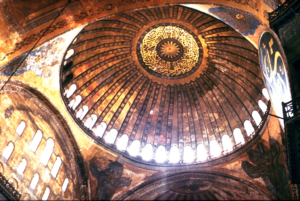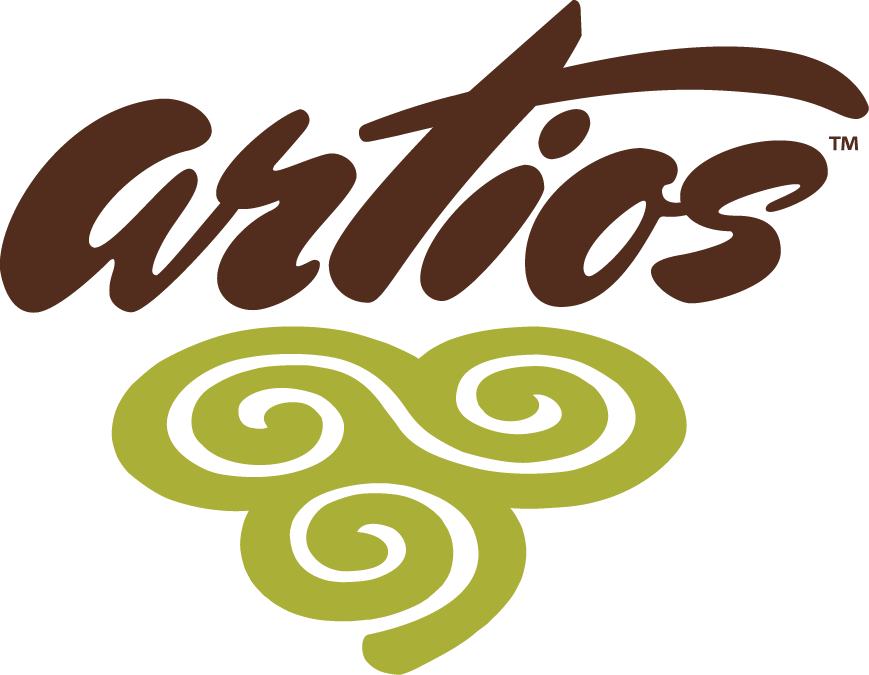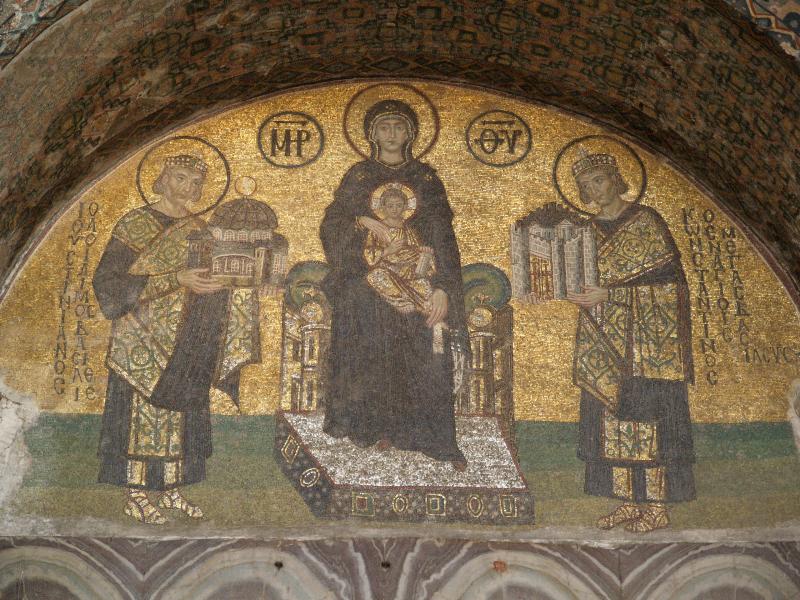[precontent]
[one_third]
Unit 3: Justinian the Great
[dropcap type=”box”]A[/dropcap]fter the fall of the Western Empire, the Eastern Empire centered in Constantinople continued on for many years. One of the great leaders of this Empire was an emperor named Justinian the Great.
[/one_third]
[two_third_last]
[/two_third_last]
[/precontent]
[three_fourth]
[box]
[box_header]
Unit 3 [flag bg_color=”#d6e3bc” text_color=”#9d241a”]High school[/flag]
[/box_header]
[box_content]
Unit Overview
- Subjects Covered
- Grammar, Literature, Composition, Social Studies
- Time Period
- Medieval – Renaissance
- Grade Level
- Highschool: 9-12
- Civilization
- Rome, Byzantine
- Literature
- The City of God by St. Augustine
[/box_content]
[box_content]
Unit Description
 Justinian the Great was an interesting historical character. He was an emperor who wanted to reunite the old Roman Empire; however, he never realized that dream. Among his accomplishments were the institutions of several educational and legal reforms. He is also known for creating The Justinian Code, which simplified and clarified all the Roman laws. This unit will look at the life, reforms, accomplishments, and failures of this Eastern Emperor.
Justinian the Great was an interesting historical character. He was an emperor who wanted to reunite the old Roman Empire; however, he never realized that dream. Among his accomplishments were the institutions of several educational and legal reforms. He is also known for creating The Justinian Code, which simplified and clarified all the Roman laws. This unit will look at the life, reforms, accomplishments, and failures of this Eastern Emperor.
[/box_content]
[box_content]
Leading Ideas and Biblical Principles
[list type=”arrow”]
- An individual’s character will be reflected in his leadership.
As a man thinketh in his heart, so is he. – Proverbs 23:7 - There is power in the spoken word to do evil or to do good.
Out of the abundance of the heart, the mouth speaketh. – Matthew 12:34 - The rise and fall of nations and leaders is determined by God. – Proverbs 21:1
[/list]
[/box_content]
[box_content]
Key Events, People, and Topics.
[list type=”arrow”]
- Justinus
- Justinian the Great
- Belisarius
[/box_content]
[/box]
[box]
[box_header]
Unit 3 Resources: [flag bg_color=”#d6e3bc” text_color=”#9d241a”]High school[/flag]
[/box_header]
[box_content]
[button id=”1″ link=”https://www.artioshcs.com/wp-content/uploads/2016/07/Unit-3-History-High-School-Medieval-Renaissance.pdf” linking=”new-window” size=”medium” type=”simple” title=”maps”]Download History Unit[/button]
[button id=”1″ link=”https://www.artioshcs.com/wp-content/uploads/2016/07/Literature-Units-1-4-High-School-Medieval-Renaissance.pdf” linking=”new-window” size=”medium” type=”simple” title=”maps”]Download Language Arts Unit[/button]
[button size=”medium” link=”http://faculty.sheltonstate.edu/~cboening/maps/Western%20Civ/Byzantine%20Empire%20(Justinian).jpg”]Download Maps[/button]
[tabs type=”simple” position=”top-left”]
[tab_title]Literature[/tab_title]
[tab_content]
[button size=”medium” link=”http://ia700409.us.archive.org/8/items/city_of_god_ds_librivox/cityofgod_11a_augustine.mp3″]Download Audio Book[/button]
[button size=”medium” link=”http://www.newadvent.org/fathers/120109.htm”]The City of God[/button]
[/tab_content]
[tab_title]Other Resources[/tab_title]
[tab_content]
Unit 3 Arts Resources
- This website has some incredible resources about Byzantine Icons.
- A virtual exploration of Byzantine Art and Architecture.
- Great slideshow of Byzantine Art.
- A great powerpoint presentation about Byzantine Art.
- A fantastic site about Life in Byzantium.
- An explanation of Byzantine Icons.
Unit 3 History Resources
Maps:
Map of Justinian the Great’s Conquest
Videos:
[/tab_content]
[/tabs]
[/box_content]
[/box]


Points to Ponder
Why so much narration?
In developing readers and writers, narration plays a key role in the development of both writing skills and comprehensions skill. Narration serves as practice in the chronological recall of key aspects of the reading and in accurately retelling what has been read. It also serves as great writing practice for the student. Often in the student’s narration, you will find them unconsciously mimicking the writing style of the reading, thus gaining practice with varied sentence structure and new vocabulary.
Points to Ponder:
1. As students and parents begin reading the articles contained in the history section, they will notice that the sentence structure and vocabulary is much more varied than that found in a typical textbook. This reading may prove to be challenging for students who are not used to more complex writing and sentence structure. However, as the student continues the reading they will not only find it easier, but their vocabulary will expand and their writing will improve based on the variety of writing styles read throughout the history section.
2. You will notice that not all of the articles chosen are written by the same author. This too, was a conscious decision on the developers of this curriculum. As we all know, the way history is perceived and recorded can vary based on an author’s personal worldview and perspective. In choosing articles by various authors, we are illustrating this fact to the student and challenging them to compare and contrast various aspects of recorded history.